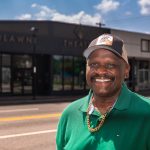Jason Avery, President of the Woodlawn Neighborhood Association and President of the Woodlawn community advisory committee (Amarr Croskey, For The Birmingham Times)
” data-medium-file=”https://www.birminghamtimes.com/wp-content/uploads/2023/09/DSC_4415-300×194.jpg” data-large-file=”https://www.birminghamtimes.com/wp-content/uploads/2023/09/DSC_4415-1024×662.jpg” />
By Ryan Michaels
The Birmingham Times
When Jason Avery attended his first meeting of the Woodlawn Neighborhood Association (NA) in 2004 he wasn’t afraid to speak up.
A business was trying to open in the neighborhood and seeking a liquor license from the city. One of the first steps in the process of getting a new liquor license is proposing the idea to the respective neighborhood associations.
Even if an NA votes “no” on the applicant’s proposal, it will still go to Birmingham City Council, which has final say-so, but support from the neighborhood makes it more likely that councilors will approve the granting of a liquor license.
Twenty years ago, Avery said, liquor licenses were “like death sentences” in people’s minds. No neighborhood would agree to them.
“[Woodlawn was] ruled by a generation who were opposed to those kinds of things and always associated any type of alcoholic beverage with crime,” Avery said.
He didn’t agree with that perspective and let those in attendance know.
“I remember getting up and saying, ‘There’s nothing wrong with the liquor license. It’s the business you need to look at,’ and they looked at me like, ‘Who is this little snot-nosed [kid]?” Avery recalled.
Avery not only got the attention of those residents but now serves as president of the NA and president of the Woodlawn community advisory committee.
Earlier this year, Woodlawn received the “Neighborhood of the Year” award at 2023 Neighborhoods USA (NUSA), a nonprofit made up of more than 500 local and national neighborhoods across the country.
One of Woodlawn’s strongest features is the relationship it has built with the business community, Avery said.
“We are seen almost as an incubator for small business but with the exception that it’s predominantly businesses of color and high concentration of female-owned businesses,” he said.
“Woodlawn’s all about equitability. Woodlawn’s all about representation, and it’s all about diversity, and I think that we’ve built that here.”
Many neighborhoods may have an identity problem stemming from Birmingham’s past “where neighborhoods were basically neglected and had no power,” he said.
“[Your neighborhood’s] been the victim of white flight. You’ve lost all your businesses so that identity that you had a long time ago is not there anymore. Plus, you have this new influx of people coming in that don’t know about your history, don’t know about what your community was great for,” Avery said.
Reassessing his neighborhood’s history, Avery said “Woodlawn has a very proud, but a really complicated, history. There have been some very bad things that have happened here during the Civil Rights movement, but you’ve got to get over it…You never forget. You always learn from everything that you do, but you can’t dwell in that old way of thinking, in those old traumas.”
To properly “move forward” neighborhood residents have to spend a lot of time discussing a vision for their community, he said.
“I think you get your folks together, you talk to them over and over again, not in one meeting, not in two meetings, over the course of years. Everybody has an opinion about who they think we should be, and I think after hearing that, putting that out in the universe for long periods of time, then it sort of comes together.”
And residents should be in the forefront of developing neighborhood plans, he said.
“We should be the ones telling our nonprofits, and our businesses what we want, and I think that those businesses should serve the residents,” Avery said.
For example, Avery pointed to public art initiatives in his Woodlawn neighborhood like “The Way,” an alley which is now covered with 11 murals from woman artists, making it the largest woman artist mural collection in the state.
That project was possible because residents engaged local businesses, nonprofits and the city’s Public Works Department, Avery said. Initiatives like public art also help create a show the identity for neighborhoods, he added.
“I think that public art should represent the neighborhoods in which it sits because that’s the one way that you can sort of seal your community,” he said. “When people come there, they know who you are …”











